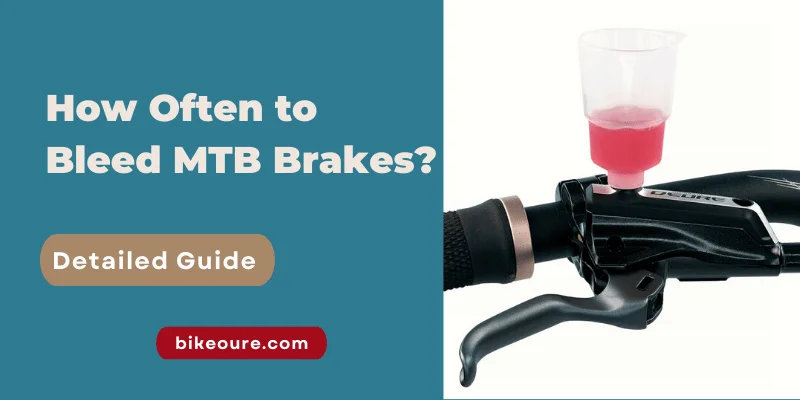An experienced mountain biker can bleed his brakes twice a year, that is, after every 6 months. Whereas a less technical rider can do it at least once a year or after two years considering he rides his bike less.
This difference is because experienced bikers ride more technical and downhill trails as compared to amateur riders. Therefore, they need brakes with great stopping power.
Contents
How Often to Bleed MTB Brakes? – Getting Started

After knowing ‘how often to bleed MTB brakes’, you might also want to know the signs that show the need for brake bleeding and how you can bleed brakes. This article will cover all these aspects of brake bleeding.
How Can You Tell Your Brakes Need Bleeding?
Here are some signs that hints your brakes need bleeding:
Spongy and Squishy Brake Lever while Pulling
Whenever you pull the brake lever, it feels spongy or squishy. This shows the presence of air inside the system. Therefore, you need to drain it out as soon as possible.
Debris on Brakes due to damaged Seals
If the brake fluid is leaking, it indicates damaged seals. Dirt or debris can find its way into the system when you have a damaged seal. Fixing or replacing them would make your brakes reliable.
Hydraulic Brake Rubber becomes Brittle
Moreover, hydraulic oil and hydraulic lines tend to wear out with time. As soon as the rubber material in the hydraulic lines becomes brittle, oil starts to leak from the system. So, you’ll have to replace the worn parts.
How to Bleed Brakes?
Brake bleeding can either be complete or a quick one. Complete bleed is the one in which you drain the oil from the brakes completely and this greatly enhances the performance of your brakes. On the other side, a quick bleed also enhances performance but is cheaper than a complete bleed. In case of a quick bleed, you take the air out and replace the oil.
Although you’ll find various brands offering hydraulic disc brakes, the most widely used and popular are the Shimano brakes. So, we are going to discuss how you can bleed them:
- You’ll need a set of Allen keys, mineral oil, and a Shimano bleed kit. Ensure everything is clean before getting into the process.
- Start by getting to the bleed point of the caliper at the lowest point of the system for moving the trapped air upwards.
- Grab the Allen key and loosen the brake lever. Then rotate the lever in a way that it becomes horizontal with the ground. Tighten it.
- Remove the bolt on top of the brake lever with an Allen key. Put the small O-ring aside that would come out of the lever.
- It is time to screw the Shimano bleed pump. Do this with your hand while keeping in mind not to over-tighten it.
- Moving towards the caliper, remove the dust cap. For some bike models, you might be required to remove the wheel to have easy access to the brake. If there is a need, go ahead and remove the wheel.
- Grab a bleed syringe followed by filling it with mineral oil. Undo the valve with a 3mm Allen key by giving it an anticlockwise turn.
- Start pumping the fluid through the cable by applying gentle pressure on the syringe. The old brake fluid will start to appear in the reservoir on the brake lever.
- Here is a tip: during pumping of the fluid, do not forget to give the cable a flick. This would prevent the air bubbles from collecting inside the system.
- When you notice a full reservoir, tighten the valve present on the caliper. Plug the hole in the reservoir and remove it from the brake lever. Throw away the old fluid and re-secure the bolt on the lever.
- Detach the hose locking device on the caliper and the hose itself. Be careful because you may spill the fluid. Clean everything before placing the dust cap back in its place.
How Often to Bleed Hydraulic Bicycle Brakes If You Don’t Ride A Lot?
Riding less does not necessarily mean that the need for bleeding brakes is no more. If you are a rider that goes biking once in a blue moon, it is best you bleed it after 2 years. Besides, bleeding brakes every 3 or 4 years is also sufficient.
You need to bleed your brakes even when the bike is not very much in use because the oil in the brakes changes its properties with time. As a result, it affects the performance of the brakes. Leaving your hydraulic brakes as it is will make them function like a cheap brake system and the whole point of buying them would go to waste.
This was all for your query, ‘how often to bleed MTB brakes’. If you still have questions, do not forget to read the answers discussed next.
Frequently Asked Questions
How often should I bleed brakes?
You can bleed your bike’s brakes after every 12 months because if you do not replace the contaminated oil, it can damage the caliper and lever seals. Besides, if your lever gives a spongy feel when you squeeze it, understand that it is time to bleed the brakes.
How often do you bleed SRAM brakes?
As per the recommendation of SRAM, you can bleed your brakes at least once a year or more if you ride on aggressive trails as it requires heavy braking.
Should you bleed MTB brakes after changing pads?
Even after changing pads, some MTB brakes still require bleeding. You can find out the need for bleeding MTB brakes by making the exchange and testing the lever feel while keeping the pads bedded in. A spongy lever or a vague bite point indicates the presence of air in the system. Therefore, you must bleed your brakes before riding it.
How much does it cost for MTB brake bleed?
To bleed MTB brakes, it will cost you somewhere between $35 and $45. But, this cost can vary from model to model. Also, if there is a need for an additional part, you’ll have to pay for that separately.
Final Takeaways from MTB Brakes Bleeding
Not bleeding your hydraulic brakes will make you lose all the benefits and performance that these expensive brakes promise. Therefore, it is necessary to maintain your brakes all the time. Otherwise, there is no point in purchasing hydraulic brakes if you are not willing to look after them.
In addition, if you avoid bleeding your brakes, this impacts the stopping power which can be dangerous for you. If your brakes do not give you great performance even after bleeding, it is time to replace them.

Hi, This is Catharine Pendrel, a professional cyclist and founder of Bikeoure. I have been riding bikes for more than 23 years and writing about cycling and other outdoor magazines for about 5 years. Mountain biking has been my passion ever since I first came across it a decade ago. I participated in various MTB tournaments and won numerous mountain trail races.
I started Bikeoure to share my expertise and cycling experience with cyclists all around the world to make them addicted to cycling. My cycling and solo traveling expertise help new cyclists find the best and latest gear in the market for their cycling adventures.